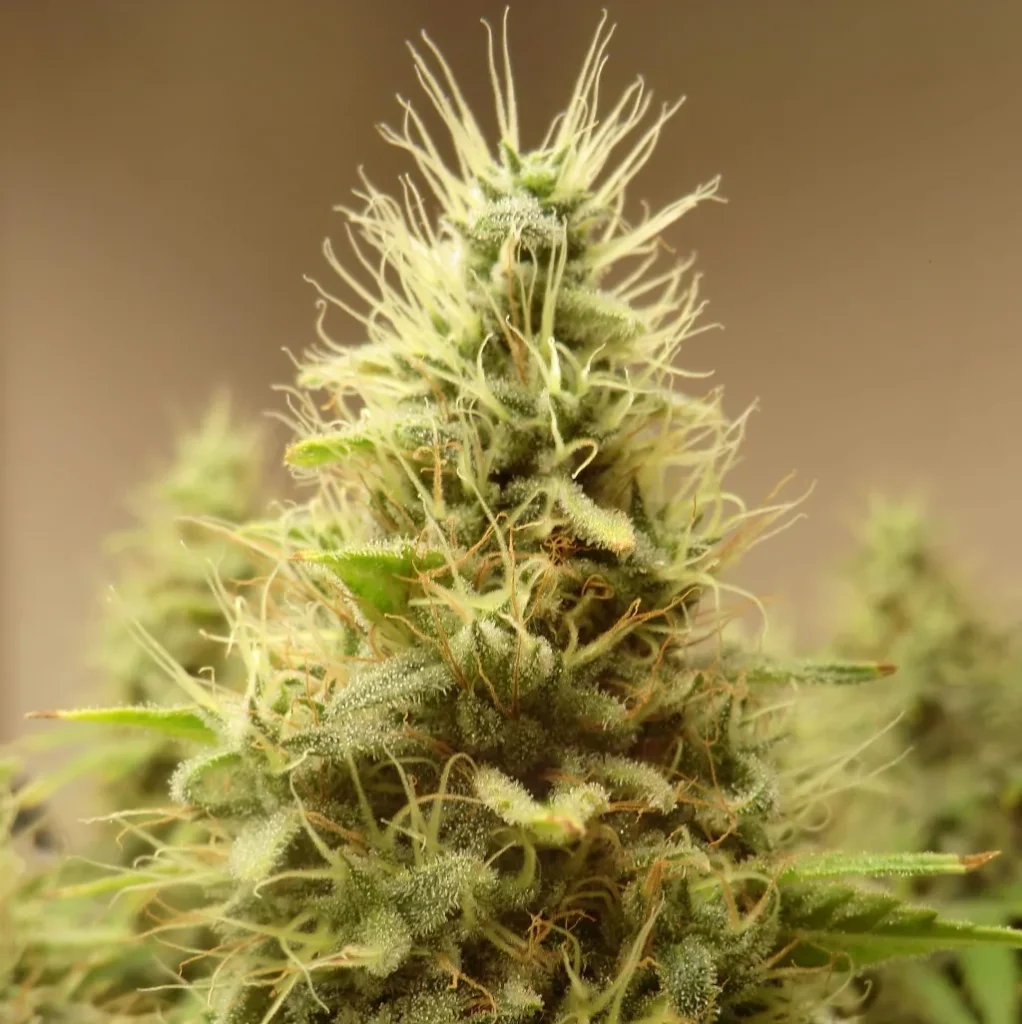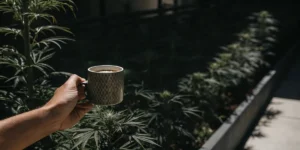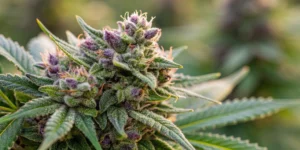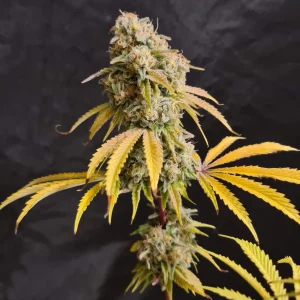Exceptional Genetics and Effects
Damnesia strain is a sativa-dominant hybrid that has captured the attention of cannabis enthusiasts worldwide. This strain results from crossing the legendary A.M.S. (Anti Mold Strain) with Amnesia Haze, creating a resilient and potent plant with distinctive effects and flavors. Known for its earthy, woody aroma with hints of spicy herbs, Damnesia stands out for its cerebral high that transitions into a relaxing body buzz. With THC levels ranging from 18% to 22%, this strain provides uplifting and energizing effects, making it a great choice for daytime use. Its balanced profile appeals to both recreational and medicinal users, offering relief from stress, fatigue, and mild pain while promoting focus and creativity.
Damnesia’s effects are well-suited for enhancing productivity or engaging in creative tasks. The strain’s ability to uplift mood while providing a calm and focused energy makes it a favorite among artists and professionals. Its unique flavor profile, characterized by herbal and earthy undertones, complements its therapeutic properties, offering an exceptional experience for consumers of all levels.
Environmental Requirements for Growing Damnesia Strain
Damnesia thrives in stable environments with moderate temperatures and controlled humidity. During the vegetative phase, temperatures between 70-85°F (21-29°C) and humidity levels of 50-70% support vigorous growth. In the flowering stage, reduce humidity to 40-50% to prevent mold and mildew while promoting dense bud formation. Good airflow is essential, whether you’re growing indoors or outdoors. Indoors, use oscillating fans and exhaust systems to maintain proper ventilation. Outdoors, Damnesia prefers Mediterranean-like climates with plenty of sunshine but can adapt to slightly cooler regions thanks to its hardy genetics.
In addition to temperature and humidity, Damnesia requires well-aerated soil or hydroponic systems to achieve optimal growth. Proper drainage prevents root rot, while nutrient-rich soil ensures steady development. Regular monitoring of environmental conditions, such as light intensity and air circulation, helps maintain healthy plants and maximize yields.
Setting Up the Growing Cannabis Space
Indoor Cannabis Cultivation
For indoor growers, Damnesia performs exceptionally well in a controlled environment. Use LED grow lights to provide full-spectrum illumination and maintain an 18/6 light schedule during the vegetative stage. Switch to 12/12 to trigger flowering. Choose high-quality soil or hydroponic systems with a pH range of 6.0-6.5 for soil and 5.5-6.0 for hydroponics. Regular pruning and low-stress training (LST) techniques optimize light penetration and airflow. A well-ventilated grow tent with carbon filters helps manage temperature, humidity, and odor effectively.
Maintaining a consistent temperature range and light schedule is crucial for indoor cultivation. Using timers and automated systems ensures precision and reduces the risk of human error. Incorporating reflective materials inside grow tents enhances light distribution, improving plant efficiency and promoting even growth.
Outdoor Cannabis Cultivation
Outdoors, Damnesia thrives in nutrient-rich, well-draining soil. Choose a sunny location that receives at least 6-8 hours of direct sunlight daily. The strain’s resilience allows it to handle occasional fluctuations in temperature and humidity, but consistent monitoring is key. Plant Damnesia after the last frost in spring, ensuring the soil is warm and fertile. Organic compost and fertilizers boost growth and enhance flavor profiles. Use stakes or trellises to support the plant’s tall structure as it matures.
Outdoor growers should protect their crops from pests and harsh weather conditions by using netting or natural barriers. Mulching around the base of the plants helps retain soil moisture and regulate temperature, ensuring steady growth throughout the season.
Propagation and Germination of Damnesia Strain
Begin with high-quality Damnesia seeds to ensure strong genetics. The paper towel method is a reliable germination technique: place seeds between damp paper towels in a warm, dark location. Within 24-72 hours, taproots should emerge, indicating the seeds are ready for planting. Transfer germinated seeds into small pots filled with light, aerated soil. Keep the medium moist but not waterlogged and maintain a temperature range of 75-80°F (24-27°C). Provide gentle light during this stage to encourage healthy seedling development.
For growers using hydroponics, start seeds in rockwool cubes or similar mediums. Ensure the cubes remain moist and maintain consistent humidity levels. Transplant seedlings into larger systems once they develop a robust root structure to support healthy vegetative growth.
Vegetative Phase of Damnesia Strain
The vegetative phase is where Damnesia’s sativa genetics shine, with rapid vertical growth and lush foliage development. Maintain an 18/6 light schedule indoors and ensure consistent sunlight outdoors. Use nitrogen-rich fertilizers to support leaf and stem growth. Pruning and training are essential during this stage. Techniques like topping and LST help manage the plant’s height and shape while improving light penetration. Regularly check for signs of nutrient deficiencies or pests and adjust care as needed.
Ensuring proper spacing between plants is vital during this phase to promote airflow and reduce the risk of mold. Adding support stakes can help manage the strain’s rapid growth, preventing branches from bending under their weight as the plant matures.
Flowering Phase of Damnesia Strain
Damnesia transitions to flowering after 8-10 weeks of vegetative growth. During this phase, reduce humidity levels and switch to bloom-specific nutrients rich in phosphorus and potassium. The flowering stage typically lasts 8-9 weeks, with buds developing a dense structure and a fragrant aroma. Monitor trichome development closely to determine the ideal harvest time. When trichomes are mostly milky with a few amber hues, the buds are at their peak potency. Maintain consistent airflow to prevent mold and ensure high-quality yields. Proper lighting during flowering is essential. Ensure even light distribution to all bud sites by adjusting lamp heights and using reflective surfaces. Regularly inspect buds for pests or signs of stress to maintain a healthy flowering environment.
Cannabis Fertilization and Nutrition – Damnesia Strain
Damnesia requires stage-specific nutrition for optimal growth. During the vegetative stage, nitrogen-rich fertilizers promote vigorous foliage development. As the plant enters flowering, switch to phosphorus- and potassium-heavy nutrients to enhance bud formation and resin production. Incorporate organic supplements like bat guano, kelp, and worm castings to improve soil quality and boost terpene profiles. Avoid overfeeding to prevent nutrient burn, and flush the plants with plain water during the final two weeks before harvest to ensure clean, flavorful buds.
Adding beneficial microbes to the soil can further enhance nutrient uptake and improve plant health. Using compost teas as a supplemental feed during key growth stages boosts both flavor and potency in the final harvest.
Pest and Disease Control for Cannabis Growing
Prevention
Preventing pests and diseases is key to a successful grow. Maintain cleanliness in your grow area and use sticky traps to monitor for insects. Apply natural deterrents like neem oil and insecticidal soap. Companion planting with pest-repelling herbs, such as basil or marigold, can further protect your plants. Ensuring proper spacing and pruning reduces humidity levels around the plant, minimizing the risk of mold and fungal infections. Regularly inspect plants for early signs of issues to maintain a healthy growing environment.
Corrective Actions
If infestations or diseases arise, act quickly to minimize damage. Introduce beneficial insects like ladybugs to combat pests naturally. For fungal issues, improve airflow and apply organic fungicides. Regular inspections ensure early detection and effective intervention. Using biological controls like predatory mites or bacteria-based treatments can address specific pest issues without harming beneficial organisms. Combine corrective actions with environmental adjustments to prevent future outbreaks.
Harvesting and Curing for Cannabis Growing
Harvest Damnesia when trichomes are predominantly milky with a few amber hues. Use sterilized scissors to trim buds and hang them upside down in a dark, ventilated space with 45-55% humidity and temperatures around 65-70°F (18-21°C). Once dried, cure the buds in airtight jars, opening them daily for the first week to release excess moisture. This curing process enhances the strain’s flavor, aroma, and potency, resulting in a premium-quality product.
Extending the curing period to 4-6 weeks can further refine the strain’s terpene profile and smoothness. Regularly monitoring humidity levels during this time ensures the buds maintain their quality and longevity.
Is Damnesia Strain Indica or Sativa?
Damnesia is a sativa-dominant hybrid, offering uplifting cerebral effects with a touch of body relaxation. Its balanced nature makes it suitable for both daytime and evening use, appealing to a wide range of cannabis consumers.
The strain’s sativa dominance provides an energetic and clear-headed experience, making it ideal for creative projects or social gatherings. Its indica lineage contributes to subtle physical relaxation, rounding out its versatile effects.
Advantages of Growing Damnesia Strain
Damnesia stands out for its robust genetics and adaptability, making it a great choice for growers in various climates. Its resistance to mold and pests ensures reliable yields, even in challenging conditions. The strain’s potent effects, unique flavor profile, and high yield potential further enhance its appeal. Additionally, Damnesia’s ability to thrive indoors and outdoors makes it a versatile option for cultivators of all experience levels.
Disadvantages of Growing Damnesia Strain
Despite its many benefits, Damnesia requires consistent care and attention. Its rapid growth necessitates regular pruning and training to maintain shape and airflow. Beginners may find its nutrient needs challenging, and improper care can lead to reduced yields or quality. Monitoring environmental conditions and maintaining a balanced feeding schedule are crucial for maximizing the strain’s potential.
Problems in Cultivating Damnesia Strain
Common challenges when growing Damnesia include nutrient deficiencies, overwatering, and pest infestations. Regular inspections and proper care can mitigate these issues. Training techniques like topping and LST optimize light penetration and airflow, reducing the risk of mold and ensuring healthy development.
Ensuring balanced soil pH levels and consistent watering schedules is essential to avoid stress-related issues. Investing in quality tools like pH meters and EC testers can help maintain optimal growing conditions.
Advanced Pest Control for Cannabis Growing
For severe pest infestations, consider integrated pest management (IPM) strategies. Biological controls like Bacillus thuringiensis effectively target caterpillars, while predatory insects such as ladybugs manage smaller pests. A clean and organized grow space minimizes the likelihood of infestations.
Using advanced methods like diatomaceous earth or biological fungicides can address more stubborn issues. Regularly rotating pest control methods prevents pests from developing resistance, ensuring long-term success.
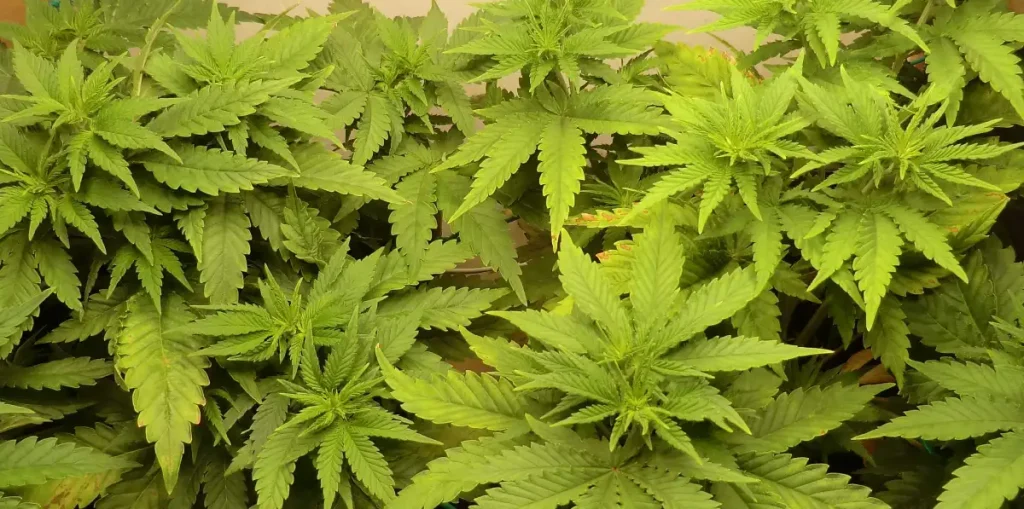
Similar Strains
Growers and enthusiasts who appreciate the unique qualities of Damnesia strain may find the following cannabis strains equally intriguing. These alternatives share similar growth characteristics, effects, and flavor profiles while offering unique traits of their own.
Amnesia Haze
Amnesia Haze is a sativa-dominant strain celebrated for its uplifting and energizing effects. Known for its citrusy and earthy aroma, it delivers a cerebral high perfect for creativity and focus. Amnesia Haze thrives in sunny outdoor environments but also performs well indoors with proper care. Its flowering time ranges from 10-12 weeks, making it a slightly longer commitment compared to Damnesia. However, the strain’s generous yields and exceptional terpene profile make the wait worthwhile.
Super Lemon Haze
Super Lemon Haze combines citrusy flavors with a refreshing burst of energy, making it a favorite among sativa lovers. This award-winning strain shares Damnesia’s uplifting effects but leans heavily into sweet and tangy flavors. Super Lemon Haze is a vigorous grower, thriving in both indoor and outdoor setups. It requires consistent care to manage its height and maximize yields, which can exceed expectations with the right techniques.
Jack Herer
Jack Herer is a classic strain that balances uplifting sativa effects with a subtle indica relaxation. Its piney, spicy aroma complements its ability to provide clear-headed euphoria, making it ideal for daytime use. Jack Herer is resilient and easy to grow, appealing to beginners and seasoned cultivators alike. Its flowering time ranges from 8-10 weeks, similar to Damnesia, and it performs exceptionally well in controlled indoor environments.
Week-by-Week Growth Plan for Damnesia Strain
Week 1-2: Germination and Seedling Stage
During the first two weeks, focus on germinating high-quality seeds and nurturing seedlings. Maintain a warm, humid environment with temperatures around 75-80°F (24-27°C) and humidity levels of 70-80%. Provide gentle lighting, such as CFLs or dimmed LEDs, to avoid overwhelming the delicate plants. Keep the soil moist but not waterlogged to encourage healthy root development. By the end of this phase, seedlings should display their first true leaves.
Week 3-5: Vegetative Growth
The vegetative stage is marked by rapid growth and the development of strong stems and leaves. Increase light intensity and maintain an 18/6 light schedule indoors. Outdoor growers should ensure plants receive at least 6-8 hours of direct sunlight daily. Feed the plants nitrogen-rich nutrients to support foliage development. Begin low-stress training (LST) to manage height and improve light penetration. Regularly check for signs of pests or nutrient deficiencies and address them promptly.
Week 6-10: Transition to Flowering
Damnesia will naturally transition to the flowering stage after approximately 8 weeks. For indoor growers, switch the light schedule to 12/12 to trigger flowering. During this phase, reduce humidity levels to 40-50% and switch to bloom-specific nutrients rich in phosphorus and potassium. Buds will begin forming and emitting a distinctive aroma. Monitor trichome development closely and maintain consistent airflow to prevent mold.
Week 11-12: Harvesting and Curing
Monitor trichomes closely for readiness, milky white trichomes with a few amber hues indicate peak potency. Use sterilized scissors to trim the buds and hang them upside down in a dark, ventilated space with 45-55% humidity. After 7-10 days of drying, transfer the buds to airtight jars for curing. Open the jars daily during the first week to release moisture, then reduce the frequency. Proper curing enhances the flavor, aroma, and potency of the final product.
FAQs About Damnesia Strain
What is the THC content of Damnesia strain?
Damnesia strain typically boasts THC levels ranging from 18% to 22%. This potency provides a balanced experience, delivering uplifting cerebral effects alongside soothing body relaxation. The strain is ideal for daytime use, offering enough energy and focus to tackle creative tasks while easing stress and fatigue.
How long does it take to grow Damnesia strain?
The complete growth cycle of Damnesia strain spans approximately 12-14 weeks. Germination and the seedling stage take 1-2 weeks, followed by a vegetative phase of 6-8 weeks. The flowering stage lasts an additional 8-9 weeks. With proper care and attention, growers can expect high yields and resin-rich buds.
What makes Damnesia strain unique?
Damnesia stands out for its exceptional genetics, combining the robust traits of A.M.S. with the potent effects of Amnesia Haze. Its earthy, woody flavor profile with spicy undertones is complemented by its sativa-dominant effects, offering euphoria, focus, and mild body relaxation. Additionally, its resilience to pests and mold makes it an excellent choice for growers seeking reliability and quality.

